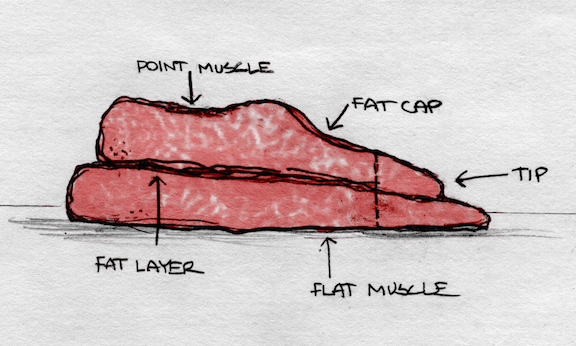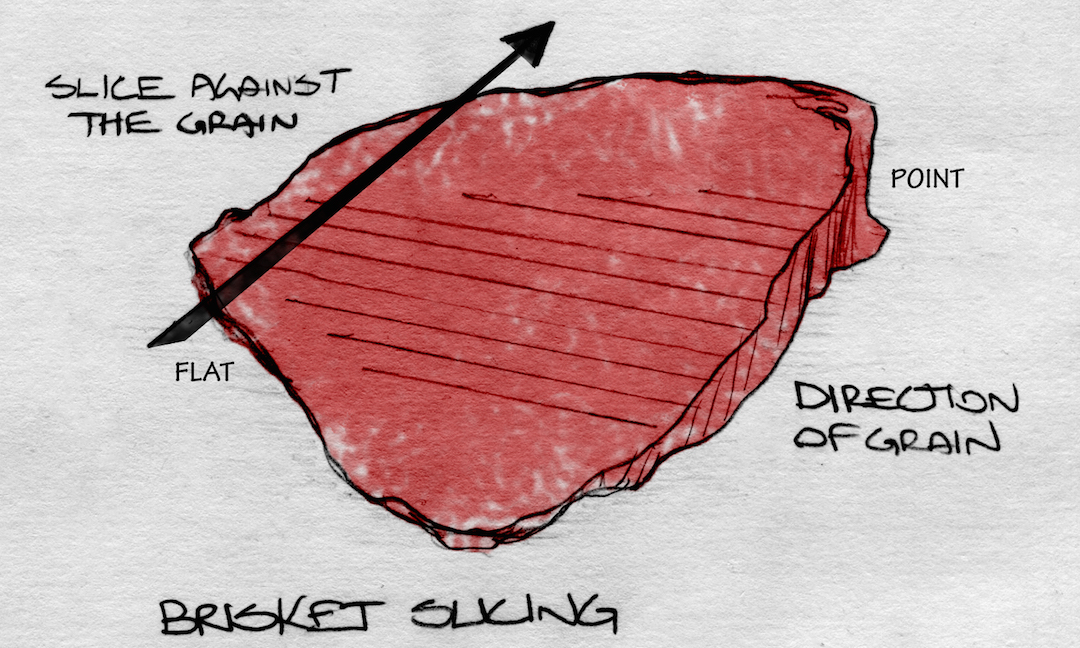It’s a great day for Team Low & Slow – we are thrilled to see “Low & Slow 2” is the #1 BBQ/Grilling book on Amazon’s Hot New Releases list! Many, MANY thanks to the fans, friends, and family for getting us there.
It’s a great day for Team Low & Slow – we are thrilled to see “Low & Slow 2” is the #1 BBQ/Grilling book on Amazon’s Hot New Releases list! Many, MANY thanks to the fans, friends, and family for getting us there.

The packer cut brisket – the brisket of choice and recommended cut when you’re cooking low and slow – is a tricky slab of meat. Butchers know this cut by its Institutional Meat Purchase Specifications number: IMPS No. 120. It is a boneless brisket with the deckle (the fat and lean between the bone and main muscle) removed. These illustrations were cut from the lineup in Low & Slow 2 (see page 85 in the book for reference), but we think they are important images because they show the top and side-view delineation between the point and the flat – the two distinct sections of a packer cut brisket. This is key visual information to know for several reasons:
1) Many barbecue beginners don’t realize that the “Texas barbecue” brisket is this huge, 12 to 15-pound hunk of meat. The “brisket” you typically find in grocery stores is not a packer cut brisket. It is the flat part of a brisket, and it has been heavily trimmed.
2) An untrimmed packer cut brisket has a thick fat cap – the hard shell of fat covering one side of the brisket – and a v-shaped wad a fat that tapers inside the brisket where the point and the flat meet. This illustration makes it easier to understand where the flat and point meet, and how the fat cap covers areas of the point and the flat, which you’ll need to know if you decide to trim the brisket (see page 85 in “Low & Slow 2”). We don’t recommend trimming your very first brisket because this fat protects the meat from drying out (although you will end up cutting a lot of it away when you are slicing and serving the meat).
3) A cooked brisket looks like a misshapen, blackened meteor (and that’s if you’ve done it right), which can make slicing difficult if you don’t understand the direction the grain runs in the two sections (it varies based on where you’re cutting). Some pitmasters remove the point and slice the two sections separately. Others slice the flat until it hits the point, then separate the two sections to slice separately. In the middle of this “BBQ with Franklin” YouTube video, Aaron Franklin slices the flat until it hits the point, then rotates the brisket 90 degrees and slices the brisket with the two sections intact. (Jump to the 6:45 mark to get right to the slicing.)
4) When you’re making Classic Burnt Ends (page 86), you’ll separate the fatty point from the flat on a cooked brisket – you do this by running a sharp knife horizontally along the fat seam between the two sections. The side view of a brisket will help you locate that fat seam.

This is my signature rub – the recipe I’m asked for most often and the one I’m most protective of. To be honest, my version never stops evolving. Sometimes I add pequin chile and habanero powder to amp up the heat. I’ll add cumin, coriander, and turbinado sugar if I’m making beef ribs. Lemon zest in the mix works will on chicken, and ground sage goes in if I’m making porks. In other words, this is a highly futz-able rub. This recipe yields a large batch, but I think you’ll find many uses for it. I throw it into everything, including dips, mayo, and salad dressing. Shameless self-promotion: The rub is also available through The Spice House (www.TheSpiceHouse.com). I like to use a blend of my favorite, dried ground Mexican chile peppers, and I always recommend toasting and grinding the whole, dried peppers instead of using pre-ground, store-bought powder.
Makes about 2 1/2 cups
10 tablespoons hot Hungarian or “half sharp” paprika
6 tablespoons garlic powder
6 tablespoons kosher salt
5 tablespoons freshly ground black pepper
3 tablespoons cayenne pepper
3 tablespoons onion powder
2 tablespoons dried oregano
2 tablespoons dried thyme
2 tablespoons chipotle powder
2 tablespoons ancho powder
1 tablespoon guajillo powder
Mix ingredients in a medium bowl and whisk thoroughly to blend. Sprinkle about 2 tablespoons of rub over each rack of ribs, or more to taste. Store leftovers in an airtight container for up to two months.
MIDWEST FRIENDS OF LOW & SLOW: Join us for the Low & Slow BBQ Pitmaster Dinner at Barn & Company on April 29th. Tickets are on sale now! This four-course meal featuring recipes from Low & Slow 2 will be paired with cocktails by Heaven Hill Distillery & beer from Great Lakes Brewing Company!
MENU
Greeting Cocktail – Heaven Hill Distillery
STARTERS paired with Great Lakes Brewery – Elliot Ness
Hot Smoke-Roasted Tri-Tip Sliders with Chimichurri Sauce
Smoked Tomato Bruschetta
ENTREES paired with Great Lakes Brewery Chillwave Double IPA
Pitmaster Porchetta with Salsa Verde
Smoked New Orleans-Style Barbecue Shrimp with crusty French Bread
SIDES
Macque Choux with Smoked Tomato & Corn
Charred Jalapeno Hush Puppies with Smoked Creole Mustard
DESSERT paired with Heaven Hill Distillery
Low & Slow Boozy Bread Pudding (Larceny Kentucky Straight Bourbon)
Call Barn & Company at (773) 832-4000 or e-mail events@barnandcompany.com to reserve your spot today!
This is a recipe that bears repeating* for a few reasons: 1) it’s a very close approximation to the famous sauce; 2) it’s delicious; and 3) we tried to sneak this into Low & Slow 2 (on sale and in stores May 2015!) to accompany the Burnt Ends cook, but our clever editor felt that republishing the same recipe in a followup cookbook was a no-no. We tried to make the case that this sauce and burnt ends were born to go together. That Mr. Bryant himself, may he rest in peace, might approve because his legendary barbecue restaurant in Kansas City put burnt ends on the map. That if only we’d known, we would have saved this recipe for Low & Slow 2 instead of parking it in the first book. To no avail. So here it is, free and for all to enjoy.
Not Arthur Bryant’s BBQ Sauce
Generations of great backyard cooks have tried to replicate the signature grit and spice of Arthur Bryant’s sauce to no avail. Do dried ground peppers make it gritty? Is pickle juice the secret vinegary ingredient? There’s no short supply of theories about what goes into the sauce to make it so unique. This version is a fair likeness, but you can also buy the real deal online. I recommend using half-sharp paprika because it lends a perfect balance of sweetness and fiery heat to a recipe. This paprika is made from a pepper that has more punch than the red bell peppers used to make sweet paprika, and it adds just the right amount of zip to this sauce.
Makes about 4 cups
2 cups water
1 1/2 cups white vinegar
1 (8-ounce) can tomato paste
1/4 cup lard
1/4 cup molasses
2 tablespoons half-sharp paprika
1 tablespoon celery seed, ground
2 teaspoons kosher salt
2 teaspoons garlic powder
2 teaspoons onion powder
1 teaspoon ground cumin
1/2 teaspoon dry mustard
Combine all of the ingredients in a large saucepan. Bring the sauce to a boil over medium-high heat, stirring frequently. Reduce heat and simmer for 45 minutes, stirring occasionally.
*Originally published in Low & Slow: Master the Art of Barbecue in Five Easy Lessons (Running Press, 2009)